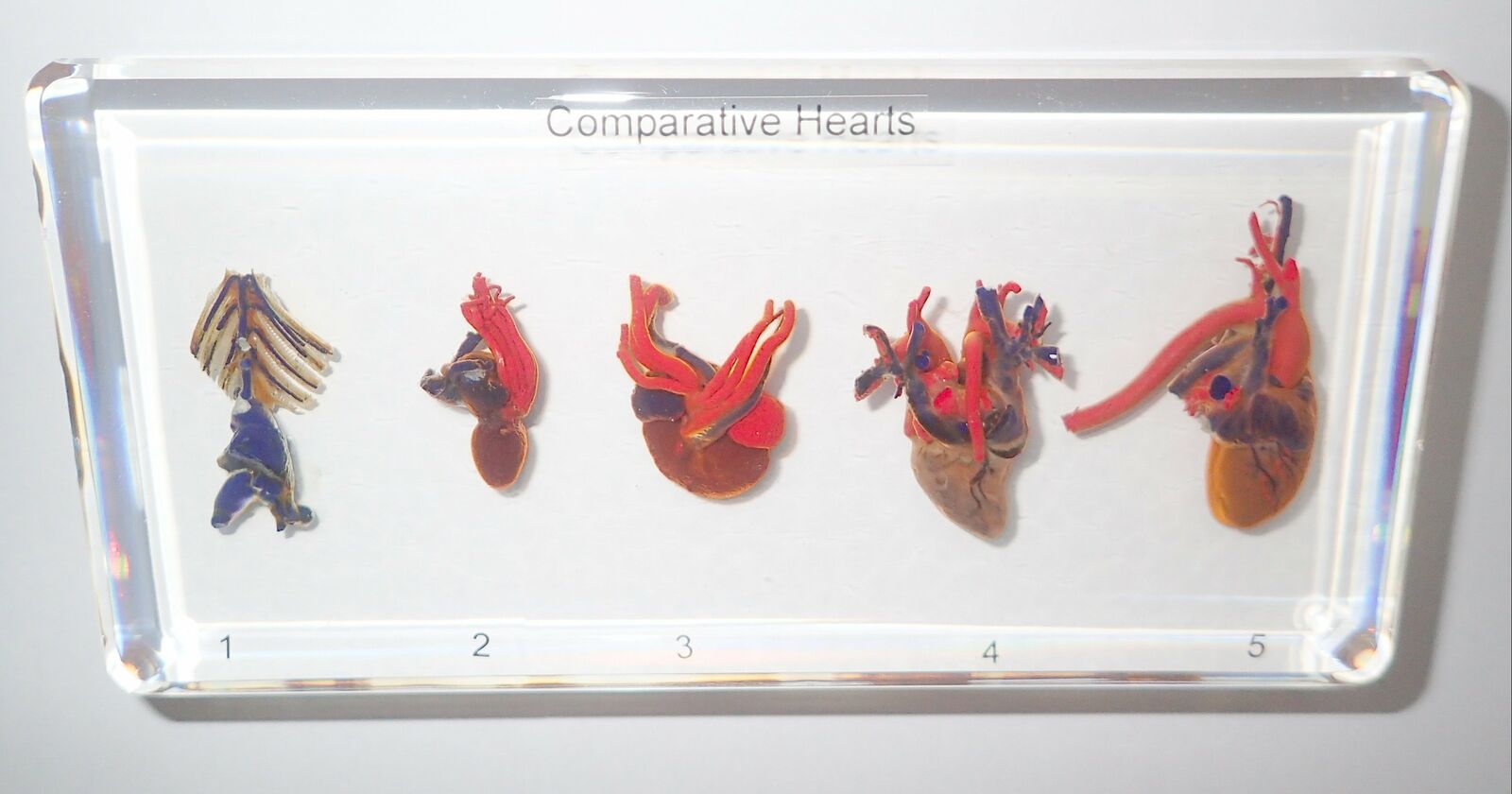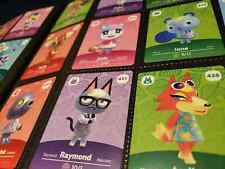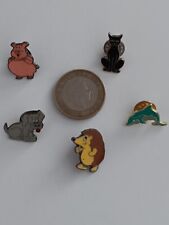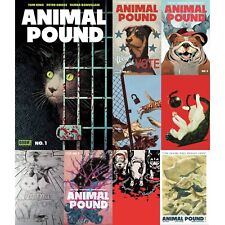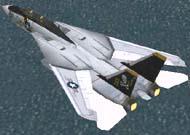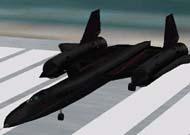When you click on links to various merchants on this site and make a purchase, this can result in this site earning a commission. Affiliate programs and affiliations include, but are not limited to, the eBay Partner Network.
A set of 5 real Animal Hearts (Fish, Amphibian, Reptile, Bird, Mammal)specimen encased in clear lucite material. The specimen is crystal clear, indestructible and transparent. Safe, authentic and completely unbreakable product put real Animal Hearts right at your fingertips!Anyone can safely explore the Animal Hearts from every angle. It is clear enough for microscope observation.Size of thelucite block is 164x78x24 mm (6.5x3.1x0.9 inch). Each one comes with a cardboard box for easy storage. Weight of thelucite block is 390 g and 500 g withpacking box.
A set of 5 real Animal Hearts (Fish, Amphibian, Reptile, Bird, Mammal)specimen encased in clear lucite material. The specimen is crystal clear, indestructible and transparent. Safe, authentic and completely unbreakable product put real Animal Hearts right at your fingertips!
Anyone can safely explore the Animal Hearts from every angle.
It is clear enough for microscope observation.
Size of thelucite block is 164x78x24 mm (6.5x3.1x0.9 inch).
Each one comes with a cardboard box for easy storage.
Weight of thelucite block is 390 g and 500 g withpacking box.
It is an ideal learning aid for students and kids and also a very good collectible item for every body.
This is a handmade real animal specimen craft. Each one will be a bit different (specimen size, color and posture) even in the same production batch.
The pictures in the listing are just for reference as we are selling multiple pieces with same Animal Hearts
Fish: Silver Carp -Hypophthalmichthys molitrix
Amphibian: East Asian Bullfrog - Rana rugulosa (Hoplobatrachus rugulosus)
Reptile: Chinese Water Snake-Enhyilris chinensis
Bird: Domestic Pigeon - Columba livia
Mammal: Domestic Rabbit - Oryctolagus cuniculus
Domestic Pigeon - Columba livia
Order: Columbiformes Family: Columofferae Genus: Columba
The Domestic Pigeon (Columba livia f. domestica) was derived from the Rock Pigeon. The Rock Pigeon is the world's oldest domesticated bird. Mesopotamian cuneiform tablets mention the domestication of pigeons more than 5,000 years ago, as do Egyptian hieroglyphics. Research suggests that domestication of pigeons was as early as ten thousand years ago. People who keep domestic pigeons are generally called pigeon fanciers. Domestic pigeons can often be distinguished from feral pigeons because they usually have a metal or plastic band around one (sometimes both) legs which shows, by a number on it, that they are registered to an owner.
Trained domestic pigeons are able to return to the home loft if released at a location that they have never visited before and that may be up to 1000 km away. A special breed, called homing pigeons has been developed through selective breeding to carry messages and members of this variety of pigeon are still being used in the sport of pigeon racing and the white release dove ceremony at weddings and funerals.
Domestic Rabbit - Oryctolagus cuniculus
Order: Lagomorpha Family: Leporidae Genus: Oryctolagus
A domestic rabbit, or more commonly known as simply the rabbit, is any of the several varieties of European rabbit that have been domesticated. Male rabbits are called bucks; females are called does. An older term for an adult rabbit is coney, while rabbit referred only to the young animals.[1] More recently, the term kit or kitten has been used to refer to a young rabbit. A young hare is called a leveret; this term is sometimes informally applied to a young rabbit as well.
There are many different breeds of domestic rabbit, with various sizes, temperments, and care requirements. As with breeds of dogs, rabbit breeds were selectively bred by humans at different times to achieve certain desired characteristics (including coat color and texture, size, and body shape). Care requirements have been greatly altered; for example, some new breeds need grooming a few times a day without fail, whereas others, such as the Holland lop, have a tendency to develop dental problems. Temperaments can vary slightly with breed and gender, as with any animal. There are over 47 rabbit breeds recognized by the American Rabbit Breeders Association in the United States. There are many more breeds of rabbits worldwide.
Chinese Water Snake - Enhydris chinensis
Order: Squamata Suborder: Serpentes Family: Colubridae Subfamily: Homalopsinae Genus: Enhydris
The Chinese water snake or Chinese smooth water snake (Enhydris chinensis) is a species of snake found in China, Taiwan, and Vietnam. As the common name suggests, it is a highly aquatic species, adapting well to human-altered environments such as fish pools and rice paddies. It is considered a very common snake. Enhydris chinensis is a relatively small snake reaching total length up to 80cm (31in). It typically feeds on fish and amphibians.
Enhydris chinensis are harvested for food and skins, but this is not considered to be threatening its populations.
Enhydris chinensis is used in folk medicine. It is commonly used in the production of Chinese snake oil. It is known for treating ailments such as fever, joint pain, and headache. It is typically ingested to gain the medicinal effects.
East Asian Bullfrog - Hoplobatrachus rugulosus
Order: Anura Family: Dicroglossidae Genus: Hoplobatrachus
Also called Chinese Edible Frog, Chinese Bullfrog, East Asian Bullfrog, or Taiwanese Frog (Hoplobatrachus rugulosus).
Description: A very large frog, second in size only to Rana spinosa, up to 12.5 cm or more in length. Olive-brown in colour, with scattered, black spots. Dorsum with many elongated wrinkles. Lips ornamented with broad, black bars. Is like an enlarged version of R. limnocharis, but can easily be distinguished from the latter by the much larger size, stocky body build, strongly tapering snout and the large eyes, which are set very close together dorsally. Flanks spotted, resembling leopard skin. A skin fold extends from behind each eye to the shoulder. Underside white. Throat with dark mottling.
Habits and habitat: Its habitat is almost identical with that of R. limnocharis, but this large species requires deeper water, and is much less common for several reasons: (1) habitat destruction (this species may be more dependent on rice paddies than R. limnocharis); (2) is relished as a food delicacy locally; (3) the widespread use of insecticide in modern farming methods. Primarily a lowland species, but has been seen in paddy areas at higher elevations, up to about 450 m.
Diet: Feeds mostly on large insects, but also on small rodents and small frogs. The gut contents of some specimens were found to contain partially digested mice.
Reproduction: Breeding season commences in early spring. Tadpoles brownish and large, 5 cm or more in total length. Young frogs about 2.5 cm at metamorphosis.
Distribution: It is found in Cambodia, China, Hong Kong, Laos, Macau, Malaysia, Myanmar, the Philippines, Taiwan, Thailand, and Vietnam. Its natural habitats are freshwater marshes, intermittent freshwater marshes, arable land, pasture land, rural gardens, urban areas, ponds, aquaculture ponds, open excavations, irrigated land, seasonally flooded agricultural land, and canals and ditches.They breed in spring–early summer.
Silver Carp - Hypophthalmichthys molitrix
Phylum: Chordata Class: Actinopterygii Order: Cypriniformes Family: Cyprinidae Genus: Hypophthalmichthys
Species: H. molitrix
The silver carp (Hypophthalmichthys molitrix) is a species of freshwater cyprinid fish, a variety of Asian carp native to north and northeast Asia. It is cultivated in China. Pound for pound, more silver carp are produced worldwide in aquaculture than any other species. Silver carp are usually farmed in polyculture with other Asian major carps, or sometimes Indian major carps or other species. It has been introduced to, or spread into via connected waterways, at least 88 countries around the world.
Silver carp is a freshwater species living in temperate conditions (6-28 °C) and its natural distribution is in Asia. This species requires static or slow-flowing water, as found in impoundments or the backwaters of large rivers. In its natural range, it is potamodromous, migrating upstream to breed; eggs and larvae float downstream to floodplain zones. While it is fundamentally benthopelagic, as an active species it swims just below the water surface and is well known for its habit of leaping clear of the water when disturbed.Silver carp are typical planktivores, the gillrakers being the main means of filtration. Silver carp consume diatoms, dinoflagellates, chrysophytes, xanthophytes, some green algae and cyanobacteria ('blue green algae'). In addition, detritus, conglomerations of bacteria, rotifers and small crustaceans are other major components of their natural diet. Silver carp spawn in late spring and summer, when the temperature of the water is relatively high. From April to August, either because of the rainstorms or the swollen upper reaches of streams and rivers, its broodstock are concentrated in spawning locations where conditions are favourable, and the current swift, complicated and irregular. Spawning temperature is generally between 18 ºC and 30 ºC, with an optimum of 22-28 ºC. The eggs of silver carp, like all Chinese carps, are non-adhesive. After spawning, the eggs begin to absorb water through the egg membrane and swell until its specific gravity is slightly greater than that of water, so they can stay at the bottom (in the case of static waters) or float halfway in mid-water (in flowing waters) until the fry hatch.
Item SpecificsCountry/Region of Manufacture :ChinaMaterial :ResinSpecies :5 AnimalsCountry of Manufacture :ChinaModified Item :NoHandmade :YesTheme :Animals
Payment
By Paypal
Shipping
Free shipping cost.
We send the goods to USA, Canada, UK, Australia, New Zealand, EU countries and some other European and Asian countries by E-express, a kind of fast postal service by Hong Kong Post. It usually takes about 6 to 10 working days for delivery.
We send the goods to other countries by registered airmail and will take about 8 to 14 working days for delivery.
Returns
Returns: We accept returns with any reason in 30 days.
Contact Us
We will answer buyer messages within 24 hours during working days.
From all around the world
DESCRIPTIONPAYMENTSHIPPINGRETURN POLICYCONTACT US 5 Animal Comparative Heart Set Fish Frog Snake Rabbit Pigeon Education Specimen
A set of 5 real Animal Hearts (Fish, Amphibian, Reptile, Bird, Mammal)specimen encased in clear lucite material. The specimen is crystal clear, indestructible and transparent. Safe, authentic and completely unbreakable product put real Animal Hearts right at your fingertips!
Anyone can safely explore the Animal Hearts from every angle.
It is clear enough for microscope observation.
Size of thelucite block is 164x78x24 mm (6.5x3.1x0.9 inch).
Each one comes with a cardboard box for easy storage.
Weight of thelucite block is 390 g and 500 g withpacking box.
It is an ideal learning aid for students and kids and also a very good collectible item for every body.
This is a handmade real animal specimen craft. Each one will be a bit different (specimen size, color and posture) even in the same production batch.
The pictures in the listing are just for reference as we are selling multiple pieces with same Animal Hearts
Fish: Silver Carp -Hypophthalmichthys molitrix
Amphibian: East Asian Bullfrog - Rana rugulosa (Hoplobatrachus rugulosus)
Reptile: Chinese Water Snake-Enhyilris chinensis
Bird: Domestic Pigeon - Columba livia
Mammal: Domestic Rabbit - Oryctolagus cuniculus
Domestic Pigeon - Columba livia
Order: Columbiformes Family: Columofferae Genus: Columba
The Domestic Pigeon (Columba livia f. domestica) was derived from the Rock Pigeon. The Rock Pigeon is the world's oldest domesticated bird. Mesopotamian cuneiform tablets mention the domestication of pigeons more than 5,000 years ago, as do Egyptian hieroglyphics. Research suggests that domestication of pigeons was as early as ten thousand years ago. People who keep domestic pigeons are generally called pigeon fanciers. Domestic pigeons can often be distinguished from feral pigeons because they usually have a metal or plastic band around one (sometimes both) legs which shows, by a number on it, that they are registered to an owner.
Trained domestic pigeons are able to return to the home loft if released at a location that they have never visited before and that may be up to 1000 km away. A special breed, called homing pigeons has been developed through selective breeding to carry messages and members of this variety of pigeon are still being used in the sport of pigeon racing and the white release dove ceremony at weddings and funerals.
Domestic Rabbit - Oryctolagus cuniculus
Order: Lagomorpha Family: Leporidae Genus: Oryctolagus
A domestic rabbit, or more commonly known as simply the rabbit, is any of the several varieties of European rabbit that have been domesticated. Male rabbits are called bucks; females are called does. An older term for an adult rabbit is coney, while rabbit referred only to the young animals.[1] More recently, the term kit or kitten has been used to refer to a young rabbit. A young hare is called a leveret; this term is sometimes informally applied to a young rabbit as well.
There are many different breeds of domestic rabbit, with various sizes, temperments, and care requirements. As with breeds of dogs, rabbit breeds were selectively bred by humans at different times to achieve certain desired characteristics (including coat color and texture, size, and body shape). Care requirements have been greatly altered; for example, some new breeds need grooming a few times a day without fail, whereas others, such as the Holland lop, have a tendency to develop dental problems. Temperaments can vary slightly with breed and gender, as with any animal. There are over 47 rabbit breeds recognized by the American Rabbit Breeders Association in the United States. There are many more breeds of rabbits worldwide.
Chinese Water Snake - Enhydris chinensis
Order: Squamata Suborder: Serpentes Family: Colubridae Subfamily: Homalopsinae Genus: Enhydris
The Chinese water snake or Chinese smooth water snake (Enhydris chinensis) is a species of snake found in China, Taiwan, and Vietnam. As the common name suggests, it is a highly aquatic species, adapting well to human-altered environments such as fish pools and rice paddies. It is considered a very common snake. Enhydris chinensis is a relatively small snake reaching total length up to 80cm (31in). It typically feeds on fish and amphibians.
Enhydris chinensis are harvested for food and skins, but this is not considered to be threatening its populations.
Enhydris chinensis is used in folk medicine. It is commonly used in the production of Chinese snake oil. It is known for treating ailments such as fever, joint pain, and headache. It is typically ingested to gain the medicinal effects.
East Asian Bullfrog - Hoplobatrachus rugulosus
Order: Anura Family: Dicroglossidae Genus: Hoplobatrachus
Also called Chinese Edible Frog, Chinese Bullfrog, East Asian Bullfrog, or Taiwanese Frog (Hoplobatrachus rugulosus).
Description: A very large frog, second in size only to Rana spinosa, up to 12.5 cm or more in length. Olive-brown in colour, with scattered, black spots. Dorsum with many elongated wrinkles. Lips ornamented with broad, black bars. Is like an enlarged version of R. limnocharis, but can easily be distinguished from the latter by the much larger size, stocky body build, strongly tapering snout and the large eyes, which are set very close together dorsally. Flanks spotted, resembling leopard skin. A skin fold extends from behind each eye to the shoulder. Underside white. Throat with dark mottling.
Habits and habitat: Its habitat is almost identical with that of R. limnocharis, but this large species requires deeper water, and is much less common for several reasons: (1) habitat destruction (this species may be more dependent on rice paddies than R. limnocharis); (2) is relished as a food delicacy locally; (3) the widespread use of insecticide in modern farming methods. Primarily a lowland species, but has been seen in paddy areas at higher elevations, up to about 450 m.
Diet: Feeds mostly on large insects, but also on small rodents and small frogs. The gut contents of some specimens were found to contain partially digested mice.
Reproduction: Breeding season commences in early spring. Tadpoles brownish and large, 5 cm or more in total length. Young frogs about 2.5 cm at metamorphosis.
Distribution: It is found in Cambodia, China, Hong Kong, Laos, Macau, Malaysia, Myanmar, the Philippines, Taiwan, Thailand, and Vietnam. Its natural habitats are freshwater marshes, intermittent freshwater marshes, arable land, pasture land, rural gardens, urban areas, ponds, aquaculture ponds, open excavations, irrigated land, seasonally flooded agricultural land, and canals and ditches.They breed in spring–early summer.
Silver Carp - Hypophthalmichthys molitrix
Phylum: Chordata Class: Actinopterygii Order: Cypriniformes Family: Cyprinidae Genus: Hypophthalmichthys
Species: H. molitrix
The silver carp (Hypophthalmichthys molitrix) is a species of freshwater cyprinid fish, a variety of Asian carp native to north and northeast Asia. It is cultivated in China. Pound for pound, more silver carp are produced worldwide in aquaculture than any other species. Silver carp are usually farmed in polyculture with other Asian major carps, or sometimes Indian major carps or other species. It has been introduced to, or spread into via connected waterways, at least 88 countries around the world.
Silver carp is a freshwater species living in temperate conditions (6-28 °C) and its natural distribution is in Asia. This species requires static or slow-flowing water, as found in impoundments or the backwaters of large rivers. In its natural range, it is potamodromous, migrating upstream to breed; eggs and larvae float downstream to floodplain zones. While it is fundamentally benthopelagic, as an active species it swims just below the water surface and is well known for its habit of leaping clear of the water when disturbed.Silver carp are typical planktivores, the gillrakers being the main means of filtration. Silver carp consume diatoms, dinoflagellates, chrysophytes, xanthophytes, some green algae and cyanobacteria ('blue green algae'). In addition, detritus, conglomerations of bacteria, rotifers and small crustaceans are other major components of their natural diet. Silver carp spawn in late spring and summer, when the temperature of the water is relatively high. From April to August, either because of the rainstorms or the swollen upper reaches of streams and rivers, its broodstock are concentrated in spawning locations where conditions are favourable, and the current swift, complicated and irregular. Spawning temperature is generally between 18 ºC and 30 ºC, with an optimum of 22-28 ºC. The eggs of silver carp, like all Chinese carps, are non-adhesive. After spawning, the eggs begin to absorb water through the egg membrane and swell until its specific gravity is slightly greater than that of water, so they can stay at the bottom (in the case of static waters) or float halfway in mid-water (in flowing waters) until the fry hatch.
Item SpecificsCountry/Region of Manufacture :ChinaMaterial :ResinSpecies :5 AnimalsCountry of Manufacture :ChinaModified Item :NoHandmade :YesTheme :Animals
Payment
By Paypal
Shipping
Free shipping cost.
We send the goods to USA, Canada, UK, Australia, New Zealand, EU countries and some other European and Asian countries by E-express, a kind of fast postal service by Hong Kong Post. It usually takes about 6 to 10 working days for delivery.
We send the goods to other countries by registered airmail and will take about 8 to 14 working days for delivery.
Returns
Returns: We accept returns with any reason in 30 days.
Contact Us
We will answer buyer messages within 24 hours during working days.
All right reserved.
Shop CategoryStore Home animals Tektite◈Loose lots◈Single stone◈Silver wired pendant◈Tiktite hanger Lapis Lazuli▷Polished stones♢Loose lots♢Single stones▷Rough stones♢Loose lots♢Single stone◈Craft items Turquoise◈Natural turquoise◈Turquoise substitutes Stone carving Rough Stone & mineral◈Single piece◈Loose lots Polished Stone & mineral◈Single piece◈Loose lots Rough ruby & sapphire◈Ruby◈Sapphire Star Ruby & Sapphire◈Star Ruby - Opaque◈Star Ruby - Transparent◈Blue Star Sapphire◈Star Sapphire - other colors Animal specimen items◈Life cycle◈Collection set◈Key ring◈Bracelet or bangle◈Necklace or ball◈Laminated specimen◈Computer Opener◈Dome animal♢Bug♢Bee, wasp, hornet♢Other insects♢Bat♢Other animal▷Butterfly♢Butterfly paperweight♢Laminated butterfly Plant Cycle◈Collection Set◈Laminated items◈Seed or root Stone, mineral, fossil box set Jewelry crafts Paper cuts◈Small set OtherHot Item Black Indochinite Tektite Stone 0.5 to 15 gram size Small Pieces 80 gram Lot USD 14.00 10 Mohs Scale Stone Set clear plastic box Learning Real Specimen Kit USD 18.00 Chinese Water Snake Skeleton in 110x45x18 mm Block Education Animal Specimen USD 24.00 Black Indochinite Tektite Stone 10 pieces Plastic Box Set Natural Specimen Kit USD 16.00 Spotted Lanternfly Cicada Life Cycle Simplified Set Real Specimen Learning Aid USD 15.00 Picture
New List Item Afghanistan Clear Quartz Crystal Stone 51 to 100 gram Size Pieces 0.3 Kg Lot USD 24.99 Spodumene Kunzite Hiddenite Triphane All Lilac over 10 gram Pieces 80 gram Lot USD 29.99 Peridot Stone Afghanistan Clear Olive Green up to 1.7 g Tiny Pcs 150 gram Lot USD 17.99 Tumbled Gemstone Mix Small & Tiny pieces more than 10 stones 150 gram Lot USD 13.99 Polished Black Agate Stone 0.5 to 2 g Very Small size pieces 180 gram Lot USD 17.99 Custom Item


